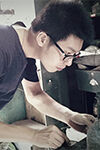Expanding the boundaries of traditional plique-à-jour: through selective laser melting (SLM) technology
This interdisciplinary research expands the boundaries of the traditional enamelling technique plique-à-jour through a combination with selective laser melting (SLM) technology. This research addresses the debate relating to how to develop this old and rare enamelling technique creatively and continuously. In recent years, the value of craft has been reconsidered within the context of the digital era. Some researchers and practitioners have proposed the hybrid craft notion that combines traditional craft and digital technology for craft sustainable development and innovative creation.
As a kind of traditional craft, plique-à-jour has changed little over the centuries. In the long history of enamel art, enamel is usually viewed as a kind of decorative material. The classic techniques including pierced, soldering, and casting have long been used to produce the metal part of plique-à-jour for a long time. The original material understanding and technical application seem to become the restrictions in developing this traditional craft.
This study aims to explore creative approaches to push the boundaries of plique-à-jour by understanding the enamel material not only from the aesthetic perspective but also from the physical property perspective, and by investigating SLM technology which is a kind of advanced direct metal printing technology. As a practice-based research, methodological approach reflexive practice with specific methods including interviews with master enamellists and goldsmiths, and studio practical experiments are deployed. This study uses a theoretical framework that combines the material experiment, technical process, and 3D modelling design into a continuous design model to work interactively and generate data continuously.
The work proposes that the integration of enamel bonding technique, dismountable structure design, and SLM technology will not only provide the creative opportunity to expand the boundary of plique-à-jour for its sustainable development but also bring a new technique and visual effect for further research areas.
